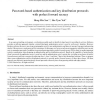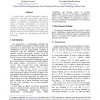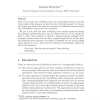25 search results - page 1 / 5 » Verifying Secrets and Relative Secrecy |
POPL
2000
ACM
13 years 8 months ago
2000
ACM
Systems that authenticate a user based on a shared secret (such as a password or PIN) normally allow anyone to query whether the secret is a given value. For example, an ATM machi...
JCSS
2006
13 years 4 months ago
2006
In an open networking environment, a workstation usually needs to identify its legal users for providing its services. Kerberos provides an efficient approach whereby a trusted th...
ENTCS
2000
13 years 4 months ago
2000
We lift Cardelli, Ghelli and Gordon's secrecy group creation operator [1] to a relative of the spicalculus that supports symmetric key cryptography, and show a natural extens...
ISCC
2009
IEEE
13 years 11 months ago
2009
IEEE
A directly public verifiable signcryption scheme is introduced in this paper that provides the security attributes of message confidentiality, authentication, integrity, non-repud...
ENTCS
2006
13 years 4 months ago
2006
There are two main ways of defining secrecy of cryptographic protocols. The first version checks if the adversary can learn the value of a secret parameter. In the second version,...



